Amaro A., Reed D., Soares P. (editors) Modelling Forest Systems
Подождите немного. Документ загружается.

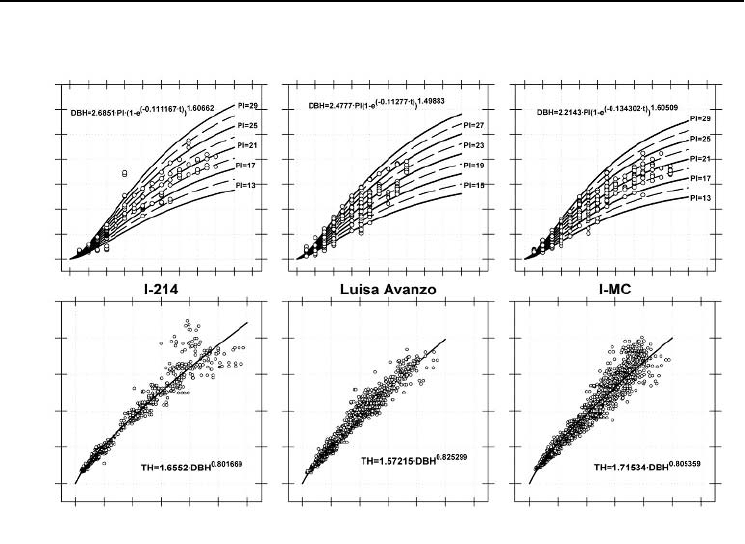
18Amaro Forests - Chap 16 1/8/03 11:53 am Page 186
186 F. Rodríguez et al.
DBH (cm)
Age (years) Age (years) Age (years)
0 2 4 6 8 101214161820 0 2 4 6 8 101214161820 0 2 4 6 8 10 12 14 16 18 20
70 70
60 60
50 50
40 40
30 30
20 20
10 10
0 0
50 50
40 40
30 30
20 20
Total height (m)
10 10
0 0
0 102030405060 0 102030405060 0 102030405060
DBH (cm) DBH (cm) DBH (cm)
Fig. 16.2. Productivity curves and height–DBH relationship for each clone.
Discussion and Conclusions
In model 2, ‘a’ represents the asymptote of the curve, ‘c’ a shape parameter impor-
tant for determining the lower inflection point of the curve, and ‘b’ a parameter
reflecting the rate at which the asymptote is approached. Higher values of ‘b’ indi-
cate greater intrinsic growth rates.
An advantage of the fitted model 2 is the ability to predict the DBH develop-
ment without experimental determination of PI values. Nevertheless, pr
ediction is
advised only for short time periods.
The model has been constructed for a determinate plantation density (278
tr
ees/ha), so that this model is valid for this range of density, an aspect that is com-
mon in all the poplar plantations analysed. When comparing the performance of the
productivity curves for the three clones, it seems advisable to increase the available
data for Luisa Avanzo at ages above 12 years, due to the scarcity of plots beyond
this age for this clone. Likewise, it would also be necessary to validate all three mod-
els with independent data sets for each clone.
This study has demonstrated the existence of a great range of productivities for
the r
egion. Luisa Avanzo is a more demanding clone with regard to the site condi-
tions (nearly 20% of the plots showed a PI of 13 or less).
We are now developing a stem taper function for each of the three clones. With
the combination of pr
oductivity curves and DBH–height relationships with stem
taper functions, we expect to be able to assess the yield of the different final prod-
ucts (peeler, sawnwood and pulpwood) of the tree.

18Amaro Forests - Chap 16 1/8/03 11:53 am Page 187
187 Modelling Diameter at Breast Height Growth
Acknowledgements
The authors thank the Gobierno de Aragon for the data set of the permanent plots,
and Jordi Voltas for helpful comments and suggestions on the manuscript. This
research was partially supported by CICYT AGL2000-1255, Spain.
References
Bengoa, J.L. (1999) Curvas de calidad en altura para Quercus pyrenaica en La Rioja. Congreso de
Ordenación y Gestión Sostenible de Montes. Santiago de Compostela, Spain.
Bravo, F. (1998) Modelos de producción para Pinus sylvestris L. en el Alto Valle del Ebro.
Doctoral thesis, University of Valladolid, Spain.
Cunia, T. (1979) On sampling trees for biomass table construction: some statistical comments.
In: Proceedings of the Forestry Inventory Workshop, SAF-IUFRO. Ft Collins, Colorado, pp.
643–664.
Monserud, R.A. (1984) Height growth and site index curves for inland Douglas fir based on
stem analysis data and forest habitat type. Forest Science 30, 943–965.
Padró, A. (1982) Curvas de productividad del clon ‘I-214’ en regadío con planta R2T2 y marco
6x6 en el valle medio del Ebro. Anales INIA Serie Forestal 6, 63–73
Padró, A. (1992) Clones de Chopo para el Valle Medio del Ebro. Diputación General de Aragón,
Zaragoza, 203 pp.
Pita, P.A. (1964) Clasificación provisional de las calidades de Pinus sylvestris L. Anales Instituto
Forestal de Investigación y Experimentación, 7–25.
Richards, F.J. (1959) A flexible growth function for empirical use. Journal of Experimental Botany
10, 290–300.
Rodríguez, F., Serrano, L. and Aunós, A. (2001) Influencia del método de poda sobre el perfil
del árbol en una chopera de Luisa Avanzo con 8 años de edad, en el valle medio del Cinca
(Huesca). In: I Simposio del Chopo, Zamora, pp. 149–158.
Rueda, J., Cuevas, Y. and García-Jiménez, C. (1997) Cultivo de Chopos en Castilla y León. Junta de
Castilla y León, Valladolid, 100 pp.
SAS (1990) SAS/STAT User’s Guide, Version 6. SAS Institute, Cary, North Carolina.
Vanclay, J.K. (1994) Modelling Forest Growth and Yield: Applications to Mixed Tropical Forest. CAB
International, Wallingford, UK, 312 pp.
Wang, G.G. and Huang, S. (2000) Height growth pattern of white spruce in natural subregions
in Alberta, Canada. Forest Ecology and Management 134, 271–279.
18Amaro Forests - Chap 16 1/8/03 11:53 am Page 188

19Amaro Forests - Chap 17 25/7/03 11:07 am Page 189
17 Stand Growth and Productivity of
Mountain Forests in Southern
Siberia in a Changing Climate
N.M. Tchebakova
1
and E.I. Parfenova
1
Abstract
Local-level, bioclimatic regression models that relate stand characteristics (forest composition,
height, site quality class and wood stocking) to site climate (temperature sums, base 5°C, and
dryness index) were developed to predict the stand structure of dark-needled forest (Pinus
sibirica and Abies sibirica) climax successions and their transformations in a changing climate
over the Sayan mountain range in southern Siberia.
The models explained up to 80% of the variation in forest growth and productivity char-
acteristics. Productivity varied widely and depended on heat supply rather than moisture.
Stand tree species composition depended on moisture: dark-needled species and light-needled
tree species (Pinus sylvestris) were separated by a dryness index value of 1.0. Living phytomass
was calculated from a wood stocking model. Tree heights and living phytomass were mapped
over the mountain range under current climate conditions and a regional climate change
scenario. The model predicts that total dark-needled forest phytomass will decrease by 17% in
a warmed climate.
Introduction
The mountain forests of southern Siberia are of special interest due to their high
diversity and productivity and especially due to the most valuable tree species of
the Siberian taiga – Siberian cedar (Pinus sibirica). Two main tree species, cedar and
fir (Abies sibirica), dominate the mountain taiga forests on the windward northern
and north-western slopes (Nazimova, 1975; Smagin et al., 1980). The climate of this
region is moist, with annual precipitation varying from 500 mm at the lower eleva-
tion border of the cedar and fir forests to 1500 mm at their upper elevation border.
The combination of sufficient heat supply and plentiful water favours the occur-
rence of forests composed of cedar and fir which are rich in biodiversity. These two
species are called in Russian botanical and forestry literature ‘dark-needled’ tree
species because of their high degree of shade tolerance. These forests were formed
1
Institute of Forest, Siberian Branch, Russian Academy of Sciences, Russia
Correspondence to: ncheby@forest.akadem.ru
© CAB International 2003. Modelling Forest Systems (eds A. Amaro, D. Reed and P. Soares) 189

19Amaro Forests - Chap 17 25/7/03 11:07 am Page 190
190 N.M. Tchebakova and E.I. Parfenova
during the Holocene (Savina, 1986). Some relic species, such as the broadleaved tree
species Tilia cordata, and groundcover species (e.g. Asarum europaeum, Asperula odor-
ata, Veronica officinalis, Dryopteris fillix-mas) remain from the Tertiary in the lowland
dark-needled (‘chern’ in Russian) forests which include various ferns and tall herbs.
Chern forests covered vast areas of Siberia in the distant past (Shumilova, 1962).
From the mid-1950s, cedar forests and especially productive chern forests under-
went a significant decline due to intensive cutting. Since then, there have been many
governmental decisions to organize sustainable forestry in these forests (Semechkin
et al., 1985). Pine (Pinus sylvestris) forests, which dominate the subtaiga and forest
steppe, are found only in a narrow band of the foothills on a flat, climatically homo-
geneous area (Smagin et al., 1980).
Evaluation of the forest stand transformations of a given site caused by both
curr
ent land use and a changing climate can be performed by comparing current
stand characteristics with those at climax stages. In many studies of mountain
forests in southern Siberia, the climate was shown to be a principal environmental
factor controlling forest composition and growth potential at the climax stage
(Polikarpov, 1970; Polikarpov et al., 1986; Parfenova and Tchebakova, 2000). Stand
models based on climatic parameters are the tools to employ to evaluate transforma-
tions caused by the climate. To our knowledge, no such stand models have been
developed for these valuable mountain forests. Our goals were to build stand
regression models that predict forest composition and productivity based on site cli-
mates and to apply these models to climate change scenarios in order to evaluate
possible changes in forest structure and productivity on a local scale.
Methods
Quadratic regression models were developed that related the site climate of a plot
and stand productivity characteristics of the forests along a transect in the Kulumys
Range of the West Sayan mountains (93° E and 53° N), an area 30 km long and 20
km wide (Fig. 17.1).
Stand data for uneven-aged, mature stands only (older than 160 years for P.
sibirica and 120 years for
A. sibirica) at quasi-climax stages were derived from 412
inventory plots. Each stand was characterized by tree species composition (percent-
age of wood volume), average tree height (m) and trunk wood stocking (m
3
/ha).
Trunk wood stocking was analysed only for those stands which were 80% or more
of one tree species. Additionally, stand living phytomass (t/ha) was calculated as a
product of trunk wood stocking and the conversion coefficients representing ratios
of the different stand fractions (bark, crown, roots and understorey) to the stem
wood mass. The latter is calculated as a product of trunk wood volume and wood
density. We derived appropriate conversion coefficients for our cedar and fir stands
from Alexeyev and Birdsey (1998).
Two climatic indices – temperature sums, base 5°C (TS
5
, heat supply), and a
dryness index (DI, water supply) – were employed to characterize the site climate of
a plot. In Russian climatology, temperature sums, base 5°C, are calculated as the
sum of all positive temperatures (T) occurring for the period with daily temperature
greater than 5°C:
TS
5
=
∫
Ttd
integrated over the time period with T > T
5.
The dryness index is a ratio between available energy (radiation balance) and
the energy required to evaporate annual precipitation. To calculate radiation balance,
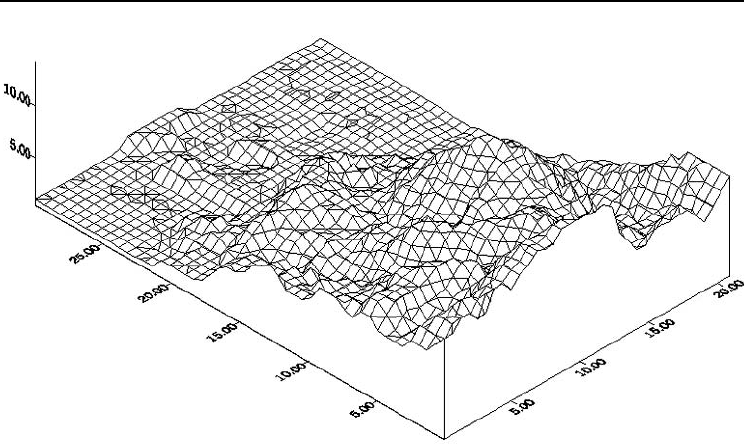
19Amaro Forests - Chap 17 25/7/03 11:07 am Page 191
191 Stand Growth and Productivity in a Changing Climate
Fig. 17.1. A digital elevation model (m, z axis) of the test transect across the Kulumys Range, an area 20 km
wide (x axis) and 30 km long (y axis).
data on temperature, humidity and cloudiness are required (Budyko, 1974;
Tchebakova et al., 1994). These climatic indices were calculated using the long-term
climatic data of 10–15 weather stations adjacent to the test transect (Reference Books,
1967–1970). Climatic submodels relating TS
5
and DI to topography (elevation, slope
and aspect when applicable) were developed to calculate climatic indices for each
plot. Climatic submodels were coupled to a local digital elevation model (DEM) that
we produced from a topographic map (1:100,000) to delineate current climatic layers
of TS
5
and DI (Fig. 17.2a and b). With a regional climate change scenario of +1.5°C
summer temperature and –4% summer precipitation (Hulme and Sheard, 1999), two
new maps of climatic layers were recalculated by adding those departures to each
pixel in the current climatic maps of TS
5
and DI. Stand models predicting tree heights
and wood stocking were coupled with current and climate change TS
5
and DI layers
to display heights and living phytomass over the test mountain range.
Results and Discussion
Stand models for predicting height, site quality class and wood stocking in cedar
and fir forests along with some statistics are given in Table 17.1. Productivity charac-
teristics were determined by a temperature factor, TS
5
, with moisture, DI, being
insignificant. The best fit of TS
5
to stand productivity characteristics was a quadratic
regression with the argument expressed by the logarithm TS
5
. The percentage of
total variation explained for growth characteristics was as high as 80% for cedar
stands and 40% for fir stands. It was less for wood stocking (Table 17.1).
In Fig. 17.3, the relationship between height and TS
5
is shown. On average,
cedar trees are 8 m taller than fir trees. This difference is less in cold climates and
greater in warm climates where cedar trees can grow to heights of 30 m or more.
Although, on average, cedar trees are taller than fir trees, wood stocking of both fir
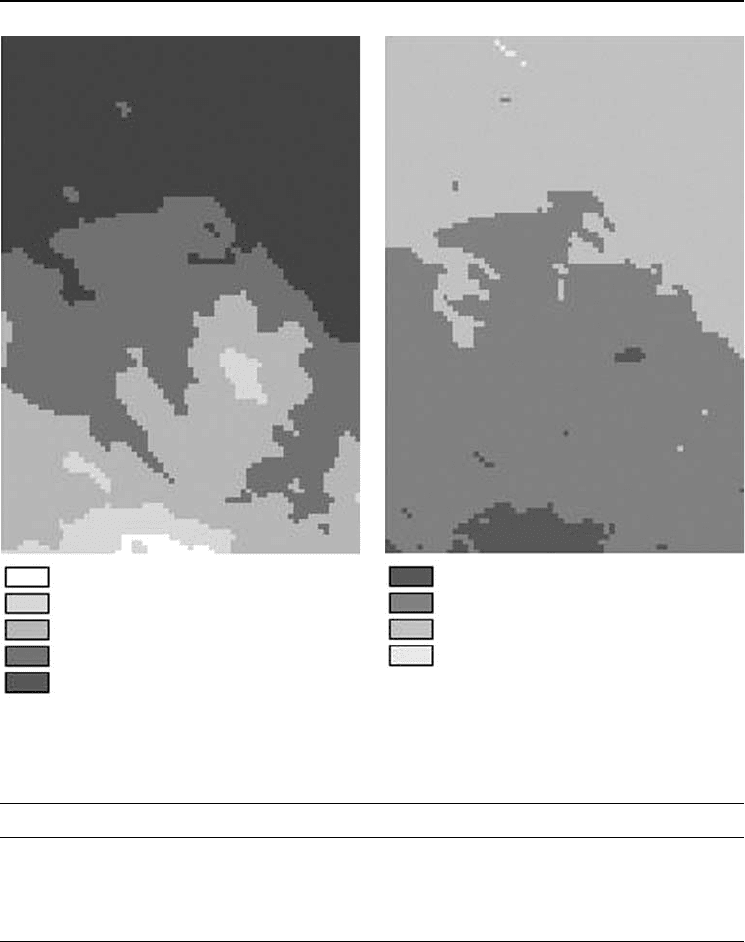
19Amaro Forests - Chap 17 25/7/03 11:07 am Page 192
192 N.M. Tchebakova and E.I. Parfenova
< 700
1500–1900
1900–2300
(a)
< 0.4
0.4–0.8
0.8–1.2
1.2–1.6
(b)
700–1100
1
100–1500
Fig. 17.2. Distribution of the current climatic layers of TS
5
(°C, a) and DI (dimensionless, b) over the study
area.
Table 17.1. Stand models for predicting growth and productivity characteristics of the Sayan mountain
forests.
All regression coefficients were statistically significant at P < 0.05.
Stand parameter Cedar stand models Fir stand models
Height (m) 2508.70+1571.70*X243.42*X
2
1729.99+1086.43*X168.41*X
2
R
2
= 0.79; SD = 4.3; n = 233 R
2
= 0.40; SD = 3.6; n = 272
Wood stocking (m
3
/ha) 48245.4+30504.5*X4797.0*X
2
R
2
= 0.30; SD = 72; n = 184
X, log (temperature sums, base 5°C, TS
5
); SD, standard deviation; n, sample size.
and cedar stands is about the same (Fig. 17.4) because the basal area of fir stands is
usually greater than that of cedar stands (Nazimova, 1975). We developed a general-
ized wood stocking model for all stands regardless of forest composition. Wood
stocking varied widely between 50 m
3
/ha in highlands and 400 m
3
/ha in lowlands.
Mountain forest composition of dark-needled stands along this transect was
rather uniform. Because the ecology of cedar and fir is quite similar
, these tree
species compete for the same sites. Prevailing species occurrence depends on a for-
est succession stage rather than climate. As follows from the climatic ordination, DI
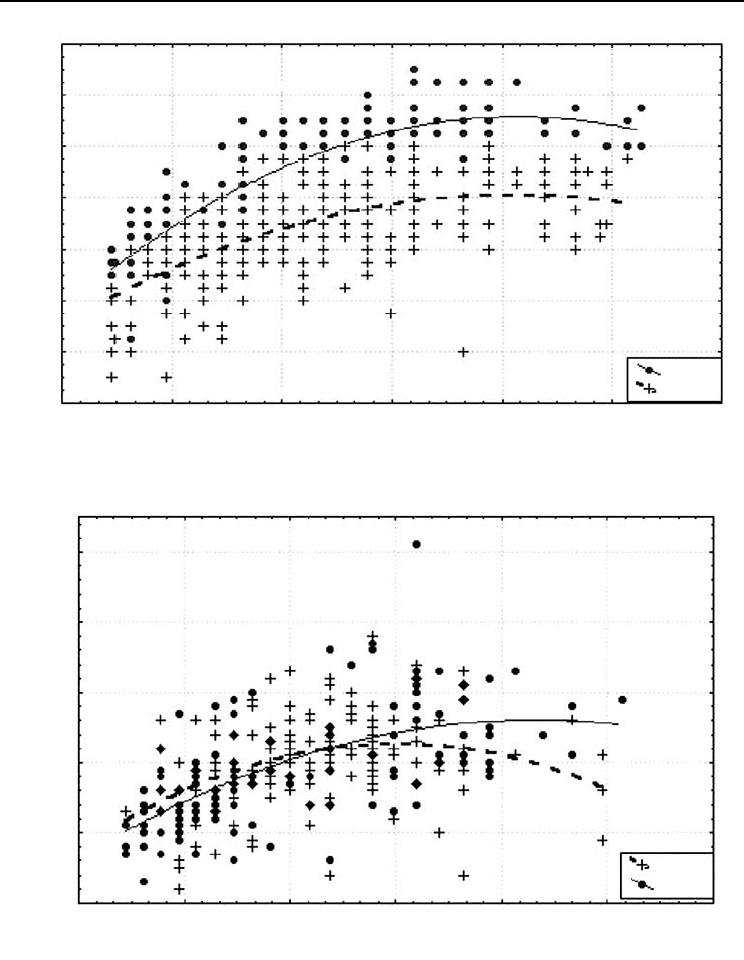
19Amaro Forests - Chap 17 25/7/03 11:07 am Page 193
193 Stand Growth and Productivity in a Changing Climate
34
30
26
22
18
14
10
6
Height (m)
2.98 3.04 3.10 3.16 3.22 3.28 3.34
Cedar
Fir
Log (temperature sum, base 5°C)
500
400
300
200
100
0
3
/ha)
Fir
Cedar
2.98 3.04 3.10 3.16 3.22 3.28 3.34
Log (temperature sum, base 5°C)
Fig. 17.3. Height (m) curves of cedar and fir depending on climate.
Wood stocking (m
Fig. 17.4. Trunk wood stocking (m
3
/ha) curves of cedar and fir depending on climate.
separated light-needled pine from dark-needled cedar and fir: light-needled pine
had DI values above 1.0 while the others were below 0.8 (Fig. 17.5). This border is
quite abrupt and clearly seen in forest maps.
Cedar and fir tree height distributions across the study area are shown in Fig.
17.6. Currently, more than a half of the study area is occupied by cedar stands with
tr
ees higher than 25 m and by fir stands with trees higher than 20 m. In a warmed
climate, the area will be almost fully covered by forests with such tall trees. From
our estimates, the tree line will shift some 250 m up-slope. Current treeless areas in
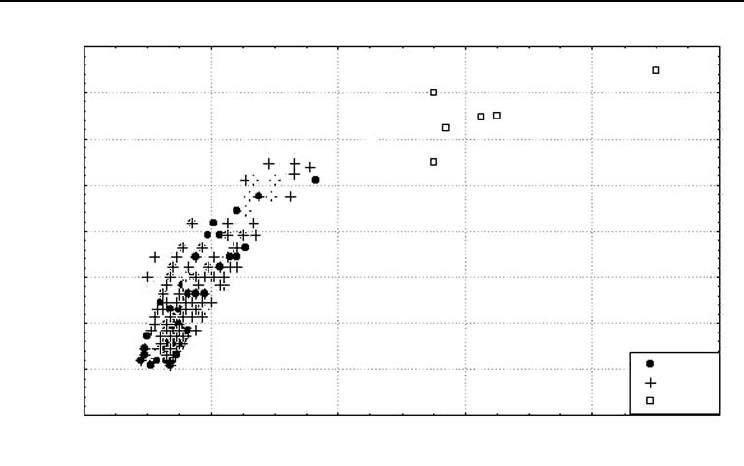
19Amaro Forests - Chap 17 25/7/03 11:07 am Page 194
194 N.M. Tchebakova and E.I. Parfenova
2400
2200
°C
2000
1800
Temperature sum, base 5
1600
1400
1200
1000
Cedar
Fir
Pine
800
0.0 0.4 0.8 1.2 1.6 2.0
Dryness index
Fig. 17.5. Ordination of dominant tree species in climatic space.
highlands will be covered by forests with rather tall trees: 20–25 m cedar trees and
15–20 m fir trees. However, from our models we cannot say that trees could grow
higher in a warmed climate than observed now. As seen from Fig. 17.3, in climates
warmer than 1600°C of TS
5
, heights of both tree species slowly start to decrease,
because under these warmer conditions a greater than presently available water
supply is required to favour tree growth. Tree growth in height may also be limited
by species biology.
Living phytomass distribution calculated from the wood stocking model
(T
able 17.1) for the current and a warmed climate across a test transect is shown in
Fig. 17.7. The data represented in the figures suggest that, under the current cli-
mate, less productive forests with a phytomass of <100 t/ha occupy only about 7%
of the forest area. In general, the climate of this region favours productive cedar
and fir forests with a phytomass >100 t/ha. In a warmed but drier climate, the area
of these forests will decrease by about 8000 ha, which is about 20% of their current
area. Dark-needled forests will shift up-slope by about 250–300 m. The pine sub-
taiga and forest-steppe area will increase by the same area correspondingly.
Although most productive forests will dominate across this area, under warming
the total forest phytomass will decrease by 0.8 Pg from 4.6 Pg today to 3.8 Pg in the
future because their total area will decrease in lowlands.
Conclusions
The productive dark-needled forests of the Sayan mountains are of special interest
both from the theoretical aspect of preserving biodiversity and from the forestry
practices aspect of sustainable forestry. The climax growth potential of these forests
and their structural changes in a changing climate can be evaluated by using biocli-
matic models where forest characteristics are defined as functions of climate.
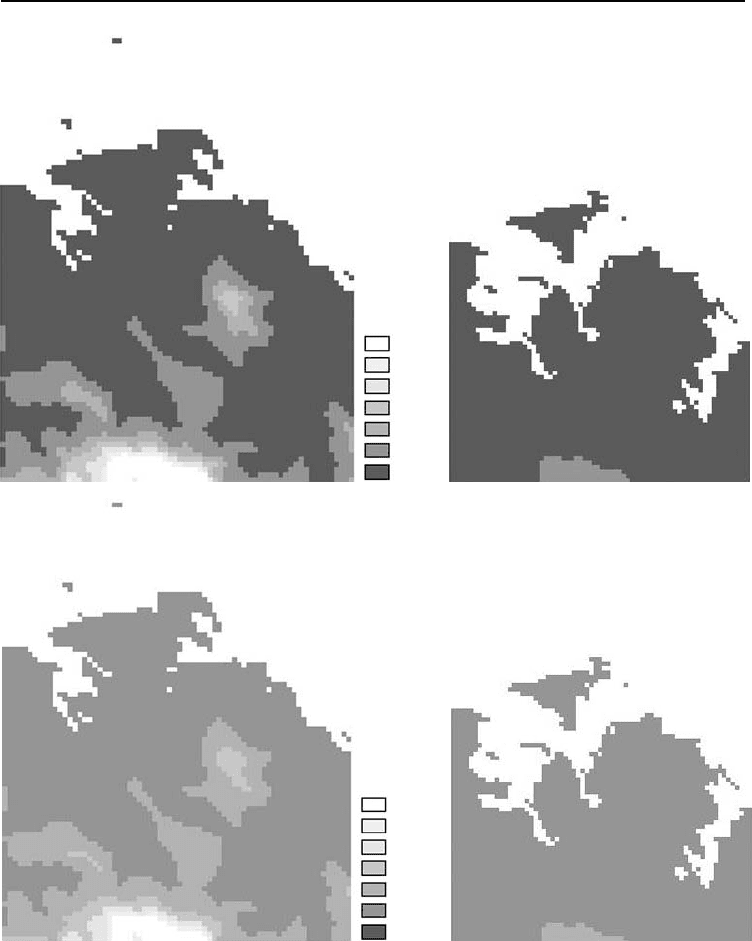
19Amaro Forests - Chap 17 25/7/03 11:07 am Page 195
195 Stand Growth and Productivity in a Changing Climate
NA
< 5
5–10
10–15
15–20
20–25
25–30
(a) (b)
(a) (b)
NA
< 5
5–10
10–15
15–20
20–25
25–30
A
B
Fig. 17.6. Height (m) distributions for cedar (A) and fir (B) across the study area under current (a) and a
warmed climate (b). NA means that a species is not available in a given pixel.
Bioclimatic stand models developed in this study allow us to evaluate growth
and productivity characteristics from temperature parameters and tree species com-
position from moisture parameters. The dryness index separates the mountain,
dark-needled (cedar and fir) forests and the light-needled, pine forests of the
foothills by the dryness index value of 1.0. Because climates across the region are
favourable for both cedar and fir, a dominant tree species in a stand is determined
